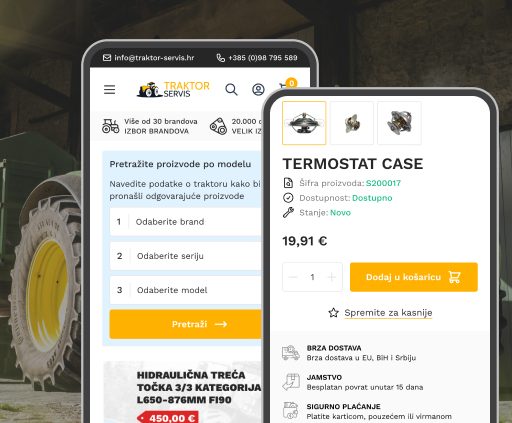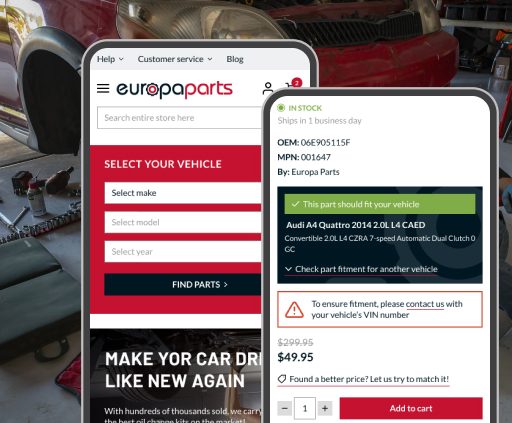
Optimizing SEO and UX for Australia’s Leading Car Parts Store
Profile
Clickable Automotive is a highly specialised online car parts store that targets the European automotive enthusiasts from Australia, New Zealand and surrounding countries.
If you need quality parts for your BMW for instance, you can find them at clickableautomotive.com.au. In no time you will also find parts for your Audi, Volkswagen and other European makes and models.
Lucas O’Brien is the Managing Director of the company located in Port Melbourne, Australia. Since the beginning, it was clear to us how knowledgeable and passionate he is about his business as well as his commitment to quality.
The store’s look-and-feel made it obvious that we were dealing with a business that is well aligned with the modern web and has a very refined taste for design. Credits should be given for the design to Gabe Lopez from Brave Nu Digital. Great work guys!
The Project
Lucas approached us with a recently developed store-front with a hybrid Magento and WordPress integration. He wasn’t overly happy with some User Experience details and wanted to make sure that the SEO best practices were in place to accelerate growth, achieve better rankings and establish an improved conversion rate from the beginning.
Inchoo’s Approach
At Inchoo, we get a lot of enquires for fixes and modifications. Sometimes, behind a small fix or apparent contained issue, lies a hacked Magento core, tons of extensions and badly written custom features – which often gets you into a scenario where you fix one problem followed by three new ones in a never ending loop.
That is the reason why we prefer not to try to win the deal with deliberate low-cost “guesstimates”. If we can not ensure quality and a perfectly stable and bug-free Magento store, we would rather not get the job. That’s part of our commitment to our clients’ satisfaction.
For most existing Magento stores and modules/extension fixes we prefer to provide our estimate after taking a good look at it. We call it the ‘Assessment Approach’.
During the assessment phase, we do a complete screening of Magento’s current situation:
- Magento core files, theme and configurations;
- Custom features and modules;
- User Experience;
- Complete in-site/off-site SEO;
- Conversion analysis.
- The deliverables at this stage are a full report on the findings with our suggestions for improvements and a quote for achieving all the initial requests and recommended improvements.
This assessment phase happens before any work is done. For Clickable Automotive, we assigned two of our Magento Certified Developers: Ivan Weiler and Domagoj Potkoc to the development side assessment.
Toni Anicic conducted the on-site/off-site SEO assessment while Lyssandro Reis performed the UX and eCommerce Design analysis.
The whole process was very transparent and Lucas didn’t have any trouble to provide us with instant feedback and establish excellent communication with our team.
This approach has been proven to be the most effective, especially when both sides envision the long-term relationship. During the assessment, we will understand the client’s business objectives better while the client will receive valuable advice on how to get the most out of Magento. At the end, we will achieve mutual understanding on how to work together, build trust and make data-driven decisions for the next steps.
Our Findings
Development
From the Magento’s back-end standpoint, the store was in pretty good shape. While the theme coding needed some polishing, the Magento Core was untouched – which is a great thing.
Clickable Automotive was a hybrid of Magento and WordPress. All the articles and content pages were being handled on WordPress, while Magento was used only for the shop. The integration needed some polishing to ensure stability, upgradability and make it seamless from the user standpoint.
To mention the two most important issues: the search functionality was not showing results from articles and products. Secondly, the user couldn’t readily know if he was logged in or not on his Magento account and, when logged in, he could not log out.
Our team also suggested a few configuration adjustments and a few front-end observations.
SEO
Toni has found a few important changes to be made. Firstly, the category navigation were passing more than 8000 uniques URLs to Google, which is a lot for a store in its early days with around 102 products and a handful of blog posts. The majority of these links were serving duplicated content due to the way the layered navigation were implemented.
At that time, the website had just been launched, which explains why many SEO measures were not in place yet. Such as: the rel=prev and rel=next pagination attributes and many other details, such as the meta tags, meta titles and so on.
User Experience/Design
Even before starting this part of the assessment, we already had the client’s heads-up regarding the most important issues that were related to the WordPress + Magento integration. Such as the problem with the ‘My Account’ accessibility and the search feature.
Overall, the design is clean, modern and well aligned to the business goals and targeted audience. However, it wasn’t clear at the first glance that it was mainly an online store. Let’s see the wire-frames:
Home-page
We suggested the inclusion of featured products on the home-page together with the ‘Quick Finder’ feature, in an effort to make a clear statement that we sell car parts. Before, you could only see products under the ‘Products’ tab, which was also replaced by ‘Store’.
Header
We suggested to add a drop-down shopping cart in the header.
Category Page
On the category page, we suggested the inclusion of the ‘Sales and Assistance’ banner in an effort to improve trust and ensure the visitor has the assistance number handy.
Other than that, we advised about a few minor details that were mostly related to contrast and minor e-commerce particularities. We also suggested a few minor improvements to the product rollover with the addition of a button for the link to the product page. A more clear organization of the elements was also suggested for the product page.
Assessment Conclusions
As explained at the beginning of this article, the assessment would bring the full report on the findings and the quote for completion of the requested and suggested tasks. In Clickable Automotive’s case, we had to decide how to proceed in regards to the WordPress + Magento Integration and the ‘Quick Finder’ feature. After that, it is just a matter of doing the work.
WordPress + Magento Integration
We often come across WP + Magento integrations. It is always a bit tricky to make the integration of Magento with WordPress seamless. We have performed this many times and are still doing it. However, we advise our clients that it brings another layer of issues when upgrading the two CMS and adding features, in most cases it is not really needed.
From the administrative standing point it makes maintaining your website a bit more complex than it already is. The client needs to log into two different admin panels, one to add articles and another to manage the shop.
If the plan is to blog one or two times per week then it may not be worth going through the trouble and it would be more beneficial to have a store that will be much faster, more manageable, cheaper to maintain, easier to upgrade and to include more features.
On the other hand, if you have somebody posting articles in a daily basis and your blog is responsible for a considerable amount of your traffic, you are right to go with the WordPress integration, you will definitely miss a few WordPress features.
Then, we could polish the WordPress integration or move away from WordPress and use the aheadWorks Blog Extension. Lucas chose to adopt a Magento Blog Extension, leaving WordPress behind – it just makes sense in this case.
Quick Finder Feature
The development of the Quick Finder module requires a project of its own. We even considered integrating it with an external database to populate the part numbers and the technical specification of each item. Although it is achievable, it would make more sense to look at it at a later stage, once the store has achieved a greater variety of products.
Lucas suggested that we provided an estimate for the development of the feature without the integration and considered the utilisation of third-party extensions. If we could find one extension that works well and suffice to our immediate needs, we could look into developing a tailored solution in a few months, after the new store has started generating a revenue that justifies it. Wise decision, totally supported by our team.
We were all in agreement and tested a handful of extensions where Lucas could understand how each one worked and how they would influence the site administration and product inclusion.
In order to do that, we install the extension on a clean Magento installation, understand how it works and test its functionalities. If it looks ok, we install on our production branch, then test again. Just to make sure it does not conflict with other custom features and extensions.
Thankfully, we found one extension that does the job. Although it adds a few extra steps when adding products to the store, we found an excellent starting feature.
Job Execution
Lyssandro has been mostly involved in the UX assessment, management tasks while promoting the communication between the team and the client.
Vanja Devcic one of our most experienced front-end developers showed great organisational skills. He has taken the lead during most of the project execution, handled all the communication with the client and provided Lucas with the support he needed to make decisions and achieve the most suitable solution when adjustments were needed or an additional requirement was brought in.
It is also important to mention that this project was ‘man-powered’ by the Certified Magento Developers: Ivan Weiler and Domagoj Potkoc.
CLIENT TESTIMONIAL
Don’t just take our word for it
Related Inchoo Services
Do you need an experienced eCommerce partner?
We combine the analytical with creative thinking to design visually attractive and high-converting eCommerce stores. Get in touch and turn your visitors into customers!






